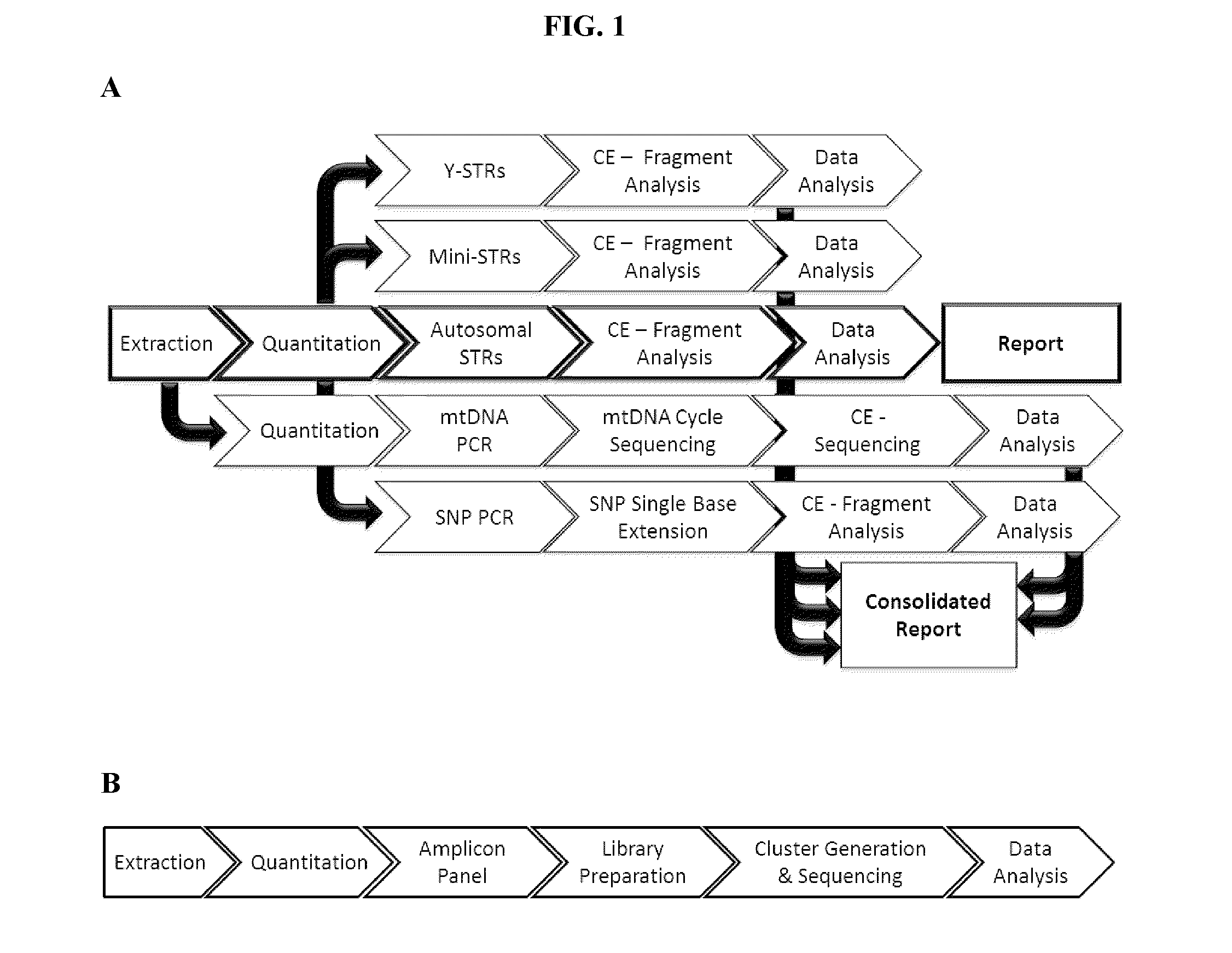Methods and compositions for DNA profiling
a dna profiling and composition technology, applied in the direction of nucleotide libraries, library screening, library creation, etc., can solve the problems of degrading dna to be analyzed, many limitations of current dna profiling methodologies, and inability to accommodate degraded dna in the size range of some markers
- Summary
- Abstract
- Description
- Claims
- Application Information
AI Technical Summary
Benefits of technology
Problems solved by technology
Method used
Image
Examples
example 1
Unconventional Primer Design
[0105]The computer design program DesignStudio from Illumina, Inc. (San Diego, Calif.) was modified and used for primer design. A skilled artisan would of course understand that alternative primer design programs such as Primer3 can also be used and the default parameters reset to mimic the intent of the modified parameters for primer design. The settings are typically reset in the config.xml file that comes with the software, however this may differ when using different software and consulting the specific materials for accessing default parameters for each software is typical practice. The following parameters can be reset in the primer design software:[0106]1) The desired minimum length amplicon reset to >60[0107]2) The desired maximum length amplicon reset to >120[0108]3) The tight candidate spacing reset to >3[0109]4) The % GC Max probe reset to >60[0110]5) The mean Tm reset to >57[0111]6) The maximum Tm reset to >60[0112]7) The minimum Tm reset to >...
example 2
DNA Profiling for Databanking
[0118]This example describes an experiment following the workflow of FIG. 2. This example does not utilize UMIs, as it could be assumed that the samples obtained are from individuals whose identity is already known.
[0119]For this experiment, STRs are multiplexed with iSNPs as found in Table 3.
TABLE 3Identity informative SNPs and STRsIdentity informative SNPsrs1005533rs1357617rs2076848rs4530059rs763869rs10092491rs1360288rs2107612rs4606077rs8037429rs1015250rs1382387rs2111980rs560681rs8078417rs1024116rs1413212rs214955rs576261rs826472rs1028528rs1454361rs221956rs6444724rs873196rs1029047rs1463729rs2269355rs6811238rs876724rs1031825rs1490413rs2342747rs6955448rs891700rs10488710rs1493232rs2399332rs7041158rs901398rs10495407rs1498553rs251934rs717302rs907100rs1058083rs1523537rs279844rs719366rs914165rs10773760rs1528460rs2830795rs722098rs917118rs10776839rs159606rs2831700rs722290rs938283rs1109037rs1736442rs2920816rs727811rs964681rs1294331rs1821380rs321198rs729172rs98764...
example 3
DNA Profiling for Criminal Casework
[0127]This example describes an experiment following the workflow of FIG. 3. This example incorporates UMIs into the primers, as it could be assumed that the samples obtained are from individuals whose identity is not already known.
[0128]For this experiment, the STRs were multiplexed with iSNPs, aSNPs and phenotypic-informative SNPs as found in Table 5.
TABLE 5case work STRs and SNPsIdentity informative SNPsrs1005533rs1357617rs2076848rs4530059rs763869rs10092491rs1360288rs2107612rs4606077rs8037429rs1015250rs1382387rs2111980rs560681rs8078417rs1024116rs1413212rs214955rs576261rs826472rs1028528rs1454361rs221956rs6444724rs873196rs1029047rs1463729rs2269355rs6811238rs876724rs1031825rs1490413rs2342747rs6955448rs891700rs10488710rs1493232rs2399332rs7041158rs901398rs10495407rs1498553rs251934rs717302rs907100rs1058083rs1523537rs279844rs719366rs914165rs10773760rs1528460rs2830795rs722098rs917118rs10776839rs159606rs2831700rs722290rs938283rs1109037rs1736442rs2920816r...
PUM
| Property | Measurement | Unit |
|---|---|---|
| Fraction | aaaaa | aaaaa |
| Melting point | aaaaa | aaaaa |
Abstract
Description
Claims
Application Information
 Login to View More
Login to View More - R&D
- Intellectual Property
- Life Sciences
- Materials
- Tech Scout
- Unparalleled Data Quality
- Higher Quality Content
- 60% Fewer Hallucinations
Browse by: Latest US Patents, China's latest patents, Technical Efficacy Thesaurus, Application Domain, Technology Topic, Popular Technical Reports.
© 2025 PatSnap. All rights reserved.Legal|Privacy policy|Modern Slavery Act Transparency Statement|Sitemap|About US| Contact US: help@patsnap.com



